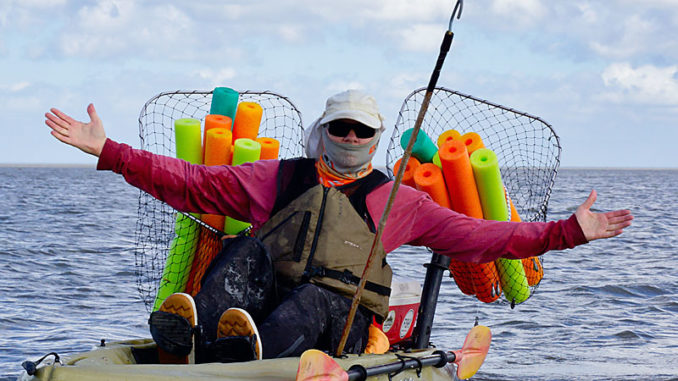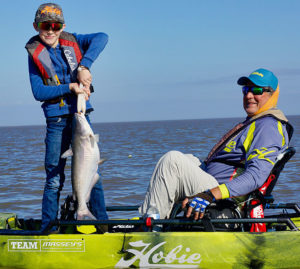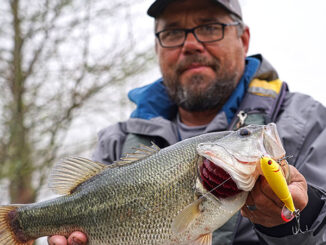
February can be one of the toughest month for catching fish in south Louisiana. Strong cold fronts often result in high winds and low, dirty, water, and fishing in a kayak on cold days can be quite uncomfortable. However, if you pick your days and dress appropriately, chasing blue catfish in Lake Pontchartrain can make for a great day of fishing.
Chris Weaver grew up in the Bucktown area and has been catching catfish in the lake since he was a kid. He tells stories of riding his bicycle to the shore and wade-fishing. A regular at West End, there are not many areas of the lake he hasn’t fished. A lot of folks think that the recent influxes of freshwater from successive years of spillway openings have caused catfish to enter the lake. There may be more in there now, but Weaver has been catching them in the lake for decades.
The one axiom of winter fishing, no matter the species, is to fish slowly. For many anglers, this is difficult. Additionally, fishing catfish with a rod and reel is generally a slow proposition. Many just don’t have the patience for it. However, Weaver has perfected a method that raises the odds for catching winter catfish and keeps kayak anglers busy in-between bites. On days without high wind or current, many baits sit out over a broad area with virtually no movement. It is quite effective for locating and enticing lethargic catfish.
Noodle rigs
Setting out with plenty of simple noodle rigs, Weaver is able to fish multiple lines at one time.
“Setting out 12 to 24 noodles ups the odds of catching much more than just sitting in one place, with one or two rod and reel lines out,” he said. “You also have to move around to set and watch the lines since they are free-floating. That keeps you busy and interested.”
Weaver’s rigs are simple, inexpensive and effective. He only uses the larger-diameter, foam pool noodles cut in half length-ways. Therefore, each noodle becomes two.
“You want to pick only the bright colors,” he said. “I’ve tried them all, but red and orange are the most visible and are much easier to see and keep track of.”
He opts for 30-pound mono in case he hooks a large fish. Once tied on, his simple dropper rig is 6 feet deep from the noodle to the sinker, with a 12-inch dropper above going to the hook. The line is tied on around the noodle a few inches from one end. He uses a two-to-three ounce sinker and a 4/0 to 5/0 circle hook.
“You want a circle hook with the center about as big around as your thumb,” he said.
For ease of transport, Weaver carries two large scoop nets to store the noodles. The lines are wrapped around with the hook imbedded in the noodle to keep them from tangling.
Where to fish

“The catfish are grubbing around the bottom eating Rangia clams,” Weaver said. “A lot of areas along the lakeshore have sandy bottoms, but you want to find the muddy areas where there are clams.”
A stake-out pole can be a good way to tell what the bottom structure is like. Use an 8-foot pole and poke and drag the tip along the bottom. It is quite easy to get a feel and be able to differentiate between sand, mud and shells.
Weaver fishes near, but not too close, to the shoreline, preferring water in the 5- to 10-foot range.
“You don’t want to be too shallow or too deep,” he said.
Catfish are not picky eaters, but cut fish is always a favorite.
“Fresh is the key, and I find chunks of pogey (menhaden) to be the best, but cut shad and speckled trout bellies also work,” he said. “I’ve even had success using sac-a-lait bellies. You don’t want to use giant chunks for these winter fish. Cut a piece in half if it looks too big.”
Bring a buddy
Keeping track of and wrangling the noodles is best done with two or more anglers. Since they are free floating, a little bit of wind can spread them out in a hurry, and with a fish on one, it can travel away fairly quickly. By tying the line closer to one end, the noodle bobs up a bit when getting bit and makes it tip up as a hooked fish pulls it along.
Weaver said this activity can be repeated in all areas of the lake.
“These catfish can be caught on the north shore, south shore, and all around the lake,” he said. “One reason I do this in winter is that I believe catfish move into the lake from the shallower surrounding areas as the water gets cold. There is also a whole lot less trash fish and bait stealers during this time. We don’t have any garfish there right now, either; they can wreak havoc on the noodles.”
Having spent decades fishing the lake, Weaver knows that it is a seasonal fishery.
On a recent trip, we set out with Weaver and his girlfriend, Nancy Bardwell. We set nearly two-dozen noodles on the south shore, with a total of six noodle wranglers in five kayaks. Weaver likes to set in a line similar to when setting crab nets. Taking note of where the bites come from, it is easy to repeat settings at the same depth as he moves along the shoreline. Our day was not ideal, as it was a bit windy, and everyone was kept busy chasing noodles both with and without fish. The fish caught were not giants, but perfect eating fish in the 3- to 10-pound range. We had plenty enough for a large fish fry. Contrary to popular belief, getting the winter blues is not a bad thing.


